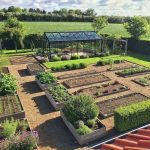Are you looking for ideas for small gardens no grass? Having a grass-free small garden can offer numerous benefits, from saving time and maintenance costs to creating a unique and visually appealing outdoor space.
In this article, we will explore innovative and practical gardening strategies for small areas that don’t rely on traditional grass lawns. From container and vertical gardening to rock gardens and raised beds, there are plenty of creative options to enhance your small garden without the need for grass.
Container gardening is one of the most popular ways to grow plants in limited spaces, allowing you to add greenery to patios, balconies, or any other small area. Vertical gardening is another excellent option that utilizes wall and fence space to create a lush garden environment while conserving precious ground space. Additionally, rock gardens offer a low-maintenance and aesthetic alternative to traditional lawns, providing an opportunity to showcase an array of beautiful plants.
In this article, we will also delve into the design aspect of grass-free small gardens, such as pathways and pavers, which not only serve a functional purpose but can also elevate the visual appeal of your outdoor space. Raised bed gardening is another fantastic way to maximize plant growth in a small area while herb and vegetable gardens provide the added benefit of growing food in a compact outdoor space.
Lastly, we will explore how adding ornamental elements can enhance the overall aesthetic of your grass-free small garden.
Container Gardening
Container gardening is an excellent solution for those with limited outdoor space and a desire for a grass-free garden. By using containers such as pots, hanging baskets, and window boxes, individuals can grow a variety of plants, flowers, herbs, and even vegetables in compact areas. This method not only adds greenery to small spaces but also brings color and vibrancy to the overall garden design.
One creative idea for small gardens no grass is to use tiered planters or vertical stacking systems to maximize vertical space. This allows for more plants to be grown in a smaller footprint, making it ideal for balconies, patios, or even tiny backyard areas. Additionally, using movable containers provides the flexibility to rearrange the garden layout as needed and experiment with different plant combinations.
When selecting containers for a small grass-free garden, it’s essential to consider the materials and sizes that will best suit the plants’ needs and the overall aesthetic of the space. Lightweight options like fiberglass or resin are great for rooftop gardens or balcony setups where weight restrictions may apply. Additionally, choosing a mix of tall, medium-sized, and trailing containers can create visual interest while also optimizing space usage.
Another approach to container gardening is to incorporate edible plants such as cherry tomatoes, lettuces, peppers, or strawberries into the design. This not only provides fresh produce but also adds functionality to the space by merging aesthetics with practicality. With proper care and attention to watering and sunlight requirements, container-grown edible plants can flourish in small grass-free gardens.
| Advantages | Examples |
|---|---|
| Maximizes limited outdoor space | Tiered planters or stacking systems |
| Provides flexibility in garden layout | Movable containers |
| Adds functionality with edible plants | Lettuces, peppers |
Vertical Gardening
Benefits of Vertical Gardening
Vertical gardening offers an innovative solution for small gardens with limited ground space. By utilizing walls, fences, and other vertical surfaces, gardeners can maximize their greenery without sacrificing valuable floor space. This approach not only provides more room for planting, but it also adds visual interest and dimension to the garden. Additionally, vertical gardens can help reduce maintenance by keeping plants off the ground and away from pests and diseases.
How to Create a Vertical Garden
There are numerous creative ways to incorporate vertical gardening into a small outdoor space. One popular method is using trellises, which provide support for climbing plants such as vines, peas, and tomatoes. Another option is installing wall-mounted planters or hanging baskets to grow flowers or herbs. For those with limited outdoor wall space, a vertical garden can also be created indoors using shelves or plant stands.
Tips for Successful Vertical Gardening
When implementing a vertical garden, it’s important to consider factors such as sunlight exposure and watering needs. Ensure that the selected plants are suitable for vertical growth and can thrive in a confined space. Proper irrigation is crucial, as plants in a vertical garden may require more frequent watering due to faster evaporation. Regular maintenance, such as pruning and training climbing vines, will also be necessary to keep the vertical garden looking its best.
By embracing the concept of vertical gardening in a small grass-free garden, individuals can transform their outdoor space into a lush oasis while making the most of limited square footage.
Rock Gardens
When it comes to small garden ideas without grass, rock gardens are a fantastic option for creating a low-maintenance and visually appealing outdoor space. Rock gardens utilize various types and sizes of stones and rocks to create a unique landscape that requires minimal upkeep. These gardens are perfect for those looking to add a touch of natural beauty to their small outdoor area without the need for extensive maintenance.
One of the advantages of rock gardens is their ability to thrive in areas where traditional grass may struggle, such as in dry or rocky soil. This makes them an ideal solution for small urban spaces or arid climates where traditional gardening may not be practical. In addition, rock gardens provide habitat for a variety of plants that thrive in rocky environments, adding interest and biodiversity to your garden.
To begin creating a rock garden in your small outdoor space, start by selecting a variety of rocks and stones in different shapes, sizes, and textures. Arrange them strategically to create visually appealing patterns and focal points within the garden.
Then, choose drought-tolerant plants such as succulents, alpines, and ornamental grasses that can thrive in the rocky environment. With proper planning and design, you can create a stunning rock garden that enhances the aesthetic appeal of your small outdoor space while minimizing the need for ongoing maintenance.
Pathways and Pavers
Designing a functional and beautiful garden space in a small area can be challenging, but with the right ideas for small gardens no grass, you can create a stunning outdoor oasis. Pathways and pavers are an essential element in any small garden, as they not only provide a practical way to move around the space but also add visual interest and structure to the landscape.
Here are some creative ideas for incorporating pathways and pavers into your grass-free small garden:
- Integrate stepping stones: Stepping stones are a great alternative to traditional pathways and can help break up the space while adding personality to your garden. Use different shapes, sizes, and materials to create a unique and visually appealing walkway.
- Create a mosaic pathway: If you have an artistic flair, consider creating a mosaic pathway using colorful tiles or broken pieces of pottery. This adds a creative touch to your garden while serving as a functional pathway.
- Install gravel paths: Gravel is an affordable and low-maintenance option for pathways in small gardens. It provides good drainage and can complement various garden styles, from modern to rustic.
In addition to pathways, pavers can also be used to define specific areas within your garden, such as seating areas or designated plant beds. By carefully planning the layout of your pathways and pavers, you can enhance the functionality and beauty of your grass-free small garden.
Raised Bed Gardening
When it comes to small gardens with little to no grass, raised bed gardening can be a game-changer. Raised beds not only provide better soil drainage and warmer soil temperatures, but they also allow for greater control over the growing environment. By using raised beds, gardeners can maximize plant growth in a confined area, making it an ideal option for those with limited outdoor space.
One of the main benefits of raised bed gardening is the ability to customize the soil composition to suit different types of plants. This is particularly useful in small gardens where space is at a premium, as it allows for efficient use of resources and optimal growing conditions. Additionally, raised beds can be designed and built at various heights, making it easier for individuals with physical limitations to access their garden without having to bend or kneel.
Another advantage of raised bed gardening in small spaces is the reduction of weed growth. By creating defined garden areas above ground level, there are fewer opportunities for weeds to encroach on precious planting space. This not only saves time and effort in maintenance but also ensures that plant growth is not hindered by competing vegetation.
Furthermore, elevated garden beds offer an aesthetic appeal and can serve as focal points within a small outdoor area. With proper design and placement, raised beds can enhance the overall look and feel of a garden while maximizing plant yield. Whether used for flowers, vegetables, or herbs, raised bed gardening provides an efficient and effective solution for those looking to make the most of their grass-free small garden.
| Raised Bed Gardening Benefits | Implications |
|---|---|
| Customized soil composition | Allows optimal growing conditions |
| Reduction of weed growth | Saves time and effort in maintenance |
| Aesthetic appeal | Enhances overall look and feel of a garden |
Herb and Vegetable Gardens
When it comes to small gardens with no grass, one of the most practical and rewarding options is to create an herb and vegetable garden. Not only does this allow you to make the most of your outdoor space by growing your own produce, but it also adds a beautiful and functional element to your garden. Here are some ideas for creating a thriving herb and vegetable garden in a compact area:
Strategic Planting
In a small garden, every inch of space counts. Utilize vertical gardening techniques by planting climbing vegetables such as cucumbers or beans against trellises or fences. This not only maximizes space but creates a visually appealing green backdrop for your garden. Additionally, consider companion planting, where certain plants are grown together to benefit each other’s growth and deter pests.
Container Gardening
For herbs and smaller vegetables, consider using containers or pots to grow your plants. This allows for easy mobility, enabling you to move them around to optimize sunlight exposure or protect them from harsh weather conditions. Mix and match different sizes and types of containers for added visual interest in your garden.
Vertical Herb Garden
If ground space is limited, why not create a vertical herb garden? Use wall-mounted planters or even repurpose pallets to create a tiered herb garden that not only saves space but also adds a unique focal point to the garden.
By implementing these ideas for small gardens no grass when creating an herb and vegetable garden, you can transform your outdoor space into a sustainable, beautiful, and productive area that provides fresh ingredients just steps away from your kitchen door.
Garden Features
When it comes to creating a small garden without grass, adding ornamental elements can be the key to enhancing the overall look and feel of the space. Incorporating decorative features not only adds visual interest but also creates an inviting atmosphere for you and your guests to enjoy. Here are some creative ideas for adding garden features to your grass-free small garden:
- Water features: Consider installing a small fountain, birdbath, or pond to bring a sense of tranquility and relaxation to your garden. The gentle sound of flowing water can create a calming ambiance, making your outdoor space a peaceful retreat.
- Garden sculptures: Adding sculptures or statues can add an artistic touch to your garden. Choose pieces that complement the style and theme of your outdoor space, whether it’s classical, modern, or whimsical.
- Arbors and trellises: These structures not only provide support for climbing plants but also serve as eye-catching architectural elements. They can help define different areas within your garden and add vertical interest.
In addition to these features, you can consider adding creative lighting options such as string lights, lanterns, or solar-powered fixtures to extend the enjoyment of your garden into the evening hours. Remember that when incorporating ornamental elements into your small garden, less is often more. Select a few carefully chosen pieces that complement the scale and style of your outdoor space without overwhelming it.
Ultimately, by incorporating these decorative features into your grass-free small garden, you can create an appealing and personalized outdoor oasis that reflects your unique taste and provides a welcoming environment for relaxation and enjoyment.
Conclusion
In conclusion, a small garden without grass can offer endless possibilities for creating a beautiful and functional outdoor space. By exploring various gardening techniques such as container gardening, vertical gardening, rock gardens, pathways and pavers, raised bed gardening, herb and vegetable gardens, and adding garden features, homeowners can transform even the tiniest of yards into a lush oasis. These ideas for small gardens no grass not only maximize limited space but also provide opportunities for creativity and personalization.
Moreover, the benefits of having a grass-free small garden extend beyond aesthetics. With minimal maintenance requirements and the potential to grow fresh herbs and vegetables, these alternative gardening methods are environmentally friendly and sustainable. From utilizing wall and fence space to incorporating ornamental elements, homeowners can design a space that reflects their unique style while also promoting biodiversity in their outdoor environment.
In essence, creating a perfect grass-free small garden is about embracing creativity and maximizing every inch of available space. By combining different gardening techniques and features, homeowners can craft a personalized outdoor retreat that not only enhances the beauty of their property but also supports a healthy ecosystem. Whether it’s through the use of vibrant containers or cultivating an edible garden, there are endless possibilities for transforming a small yard into a thriving green haven.
Frequently Asked Questions
How Do You Landscape a Small Front Yard Without Grass?
Landscaping a small front yard without grass can be achieved by incorporating alternative ground coverings such as gravel, mulch, or decorative stones. Utilizing low-maintenance plants and shrubs in containers or raised beds can also add visual interest without the need for traditional grass lawns.
What Is No Grass Landscaping Called?
No grass landscaping is often referred to as xeriscaping, which involves designing and maintaining a garden or yard with minimal water usage. This approach typically utilizes native plants, succulents, rocks, and other drought-tolerant elements to create an environmentally friendly and sustainable landscape.
What Can I Do With My Backyard That Doesn’t Grow Grass?
When dealing with a backyard that doesn’t grow grass, consider alternatives such as creating a patio or deck space for outdoor living and entertaining. Additionally, you could install hardscaping features like pathways, retaining walls, or a fire pit to enhance the functionality and aesthetics of the area.
Incorporating low-maintenance plants or artificial turf can also provide greenery without the need for traditional grass.

Welcome to my gardening blog! I am passionate about plants and enjoy sharing my knowledge and experiences with others. In this blog, I will write about everything related to gardening, from tips on how to get started to updates on my own garden projects.





